The overall efficiency of a heating system depends on running costs (fuel,
maintenance and renewal costs) as well as capital cost. Over the year the
efficiency of solid fuel central heating has increased; nevertheless it
produces more carbon dioxide than gas or oil, and probably similar amount to
electricity. The Energy Saving Trust (Domestic Heating: Solid Fuel Systems-
CE47) has stated that the efficiency of an appliance depends on:
- whether it's a closed or open appliance (stove or fire)
- combustion controls (fans, dampers etc)
- turn-down ability and range
- chimney design
- ventilation
- fuel type
- ignition method
and for a central heating system two key factors in efficiency are:
- system design (whether fully pumped or semi gravity - where the water
in the cylinder flows through gravity but the supply to the radiators is
pumped)
- the system controls.
|
|
The choice of fuel depends on availability, local smoke control regulation
and the nature of the appliance. The page on Fuel (in
Chimneys and Coal Fires) contains more information. Note that bituminous
coal (ie ordinary coal) cannot be used in smoke control areas. |
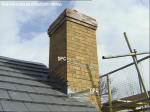
|
To work efficiently and safely a well designed and constructed chimney is
vital. The key elements of good design are that:
- it must be high enough (to provide enough updraught)
- there should be no sharp bends or obstruction
- there should be no air leakage (to prevent cooling and spread of toxic
fumes)
- the terminal needs siting in a position where it can discharge safely
without the risk of back pressure.
|
The pages on existing and new chimneys are worth reading if you want
more information on new and existing chimneys.
|
The fire should be sited on a hearth constructed in accordance with the
Building regulations.
|
In addition there must be an adequate supply of air to a solid fuel
appliance so that complete combustion takes place. Apart from the risk to
health (carbon monoxide poisoning) a lack of air will adversely affect the
updraught. |
NB. Extractor fans should not normally be installed in the same room as
an open-flued solid fuel fire.
|
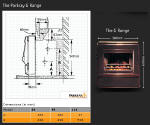 |
With the exception of fires, solid fuel appliances are referred to as
closed. Unlike gas fires or gas boilers they cannot be switched on and off,
but they can be turned down. On fan assisted models the fan can be switched
on and off - usually via a thermostat or timer. Open fires are not very
efficient and are difficult to control. They can be fitted with a back
boiler which will heat hot water for washing purposes. Some open fires have
enough output to serve a few radiators. A stove (left), unlike a fire,
usually has glass doors. It is therefore possible to control the air supply
and the rate of burning. They are generally much more efficient than open
fires. Note that a stove does no imply any cooking facilities
(although a few actually have an oven above the fire - right) although many
can be fitted with back boilers for heating purposes. The example on the
right is feature on the Stovax web site. It's one of the Austroflamm range.
This stove with a maximum heat output of up to 11kW has a steel or ceramic
finish and includes a bread oven. This particular model does not include a
back boiler. |
|
Many stoves can burn a variety of solid fuels including wood. Wood is
carbon neutral in terms of emissions.
|
Stoves with back boilers are quite popular. The stove is normally sited in
the kitchen or main living room and gives the room a focal point. They are
also very reliable and provide a local source of heat in case of central
heating failure. They need to be correctly sized - if the appliance is over
sized (in terms of heat output into the room) the stove may have to kept
burning low - this may not provide enough heat for the radiator system. One
way round it is to use a stove with a high central heating output and a low
direct fire output. - and to provide a radiator in the same room as the
stove. Some stoves have a damper which controls the heat-to-water and
heat-to-room ratio. |
|
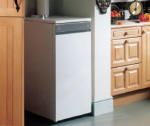 |
Solid Fuel boilers can provide full central heating for most
dwellings and are available in a wide range of outputs and sizes. Batch fed
units will provide domestic hot water and sufficient heat for a three to
four bedroom house. Gravity fed boilers (which have a large hopper over the
fire box) will operate for up to 36 hours at minimum output and for 10 hours
on full burn rate without refuelling or de-ashing. Combustion is
usually assisted by
a built-in thermostatically controlled fan, which helps adjust output to
demand. Gravity-fed units have a high turn down (around 10:1), which means
that they can kindle at low combustion rates, compared with other solid fuel
appliances. There is still some background heat given off when the boiler is
turned down to minimum, helping to prevent condensation within the dwelling. Most boilers and cookers can burn a range of fuels and are suitable for
use in Smoke Control Areas. Gravity feed boilers offer infrequent refuelling
and semi-automatic de-ashing. Batch fed boilers allow a wide range of fuels
to be burnt and some are multi-fuel. They can burn coal or wood if installed
in a Non-Smoke Control Area. The range of rated outputs for boilers is very
wide starting at 3.5kW and going up to 40kW. Solid fuel cookers (right) can
also be fitted with back boilers to provide hot water and central heating.
Their design means that they always produce some warmth - they are probably
not therefore suitable for modern, highly insulated, housing. |
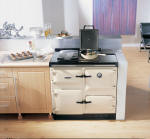 |
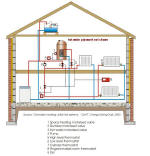 |
Solid fuel boilers must be vented. This is for reasons of safety because,
unlike gas and oil boilers, they cannot be instantly turned off. The vent
discharges over a feed and expansion cistern which accommodates the
expanding warm water. As the water heats up the level in the cistern will
rise slightly. If something goes wrong and the boiler boils (which, of
course, it never should do) the water is discharged into the cistern and out
through the overflow. The controls differ slightly from oil and gas boilers
- this is because the boiler cannot be switched off and on in the same way.
Control is normally effected by operating the pump through a programmable
room thermostat. Control of the hot water should be achieved with a
cylinder thermostat linked to a ‘normally-open’ motorised valve. An overheat
thermostat mounted on the flow pipe can operate the pump (and motorised
valves if necessary) and so dissipate any excess heat. A low limit
thermostat may also be fitted to prevent pump operation when the temperature
is too low (this helps prevent boiler corrosion). TRVs should be fitted on
all radiators except in rooms with a room thermostat or slumber radiator.
The system on the left shows a fully pumped system. It is also possible to
have a semi-gravity system - in this case the hot water to the cylinder
flows through 'gravity' and the heating is pumped. |
In some houses it is possible to link a solid fuel boiler
to an existing central heating system. This means that the system is
"dual-fired".
|
|
|
NB. HETAS (Heating Equipment Testing and
Approval Scheme) is the
official body recognised by government to Approve solid fuel domestic
heating appliances, fuels and services. Its work in Approving products
covers boilers, cookers, open fires and stoves and room heaters. It also
lists in its brochure
factory made chimneys and carbon monoxide detectors and alarms suitable for
use with solid fuel. |
|
